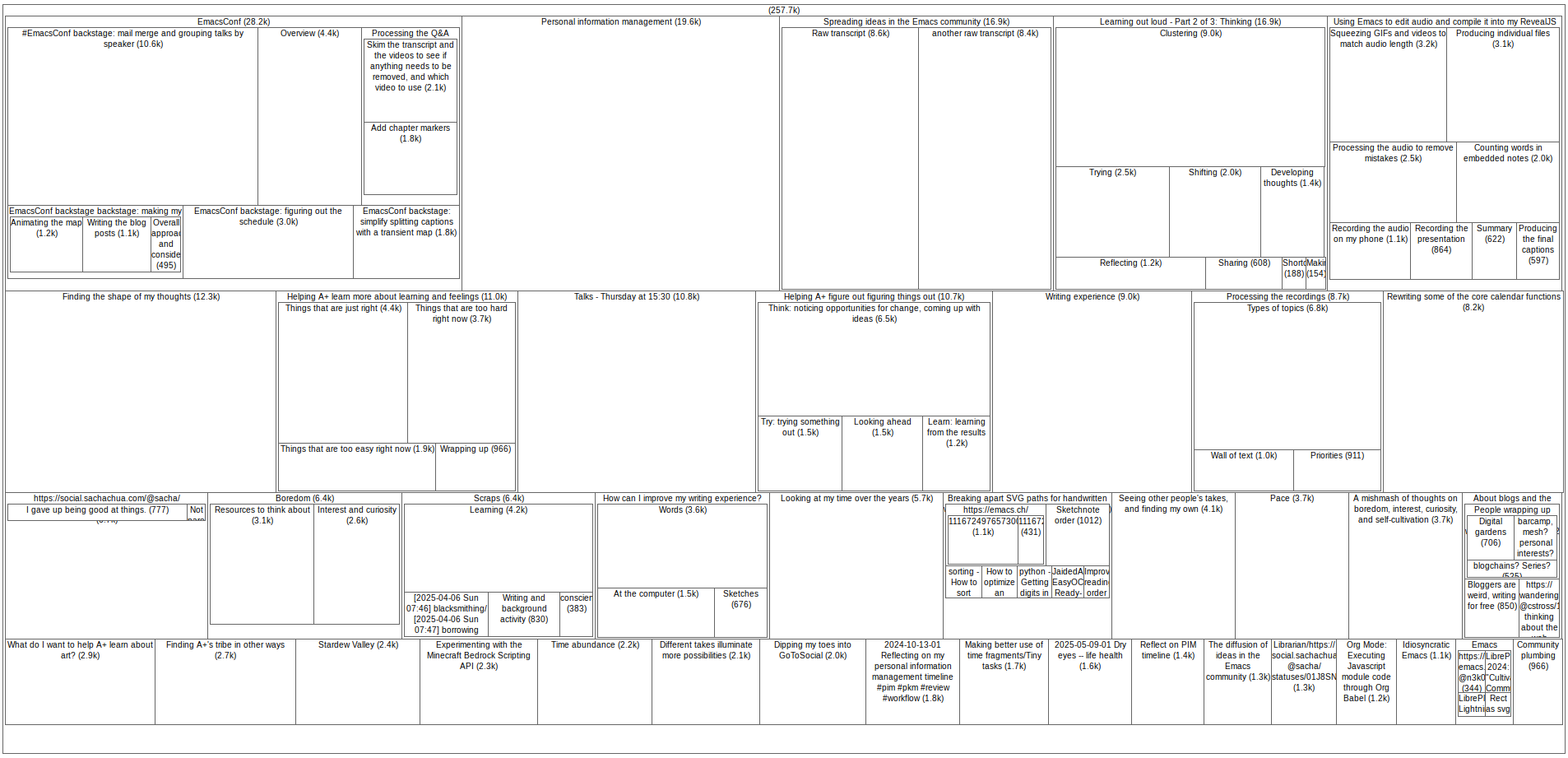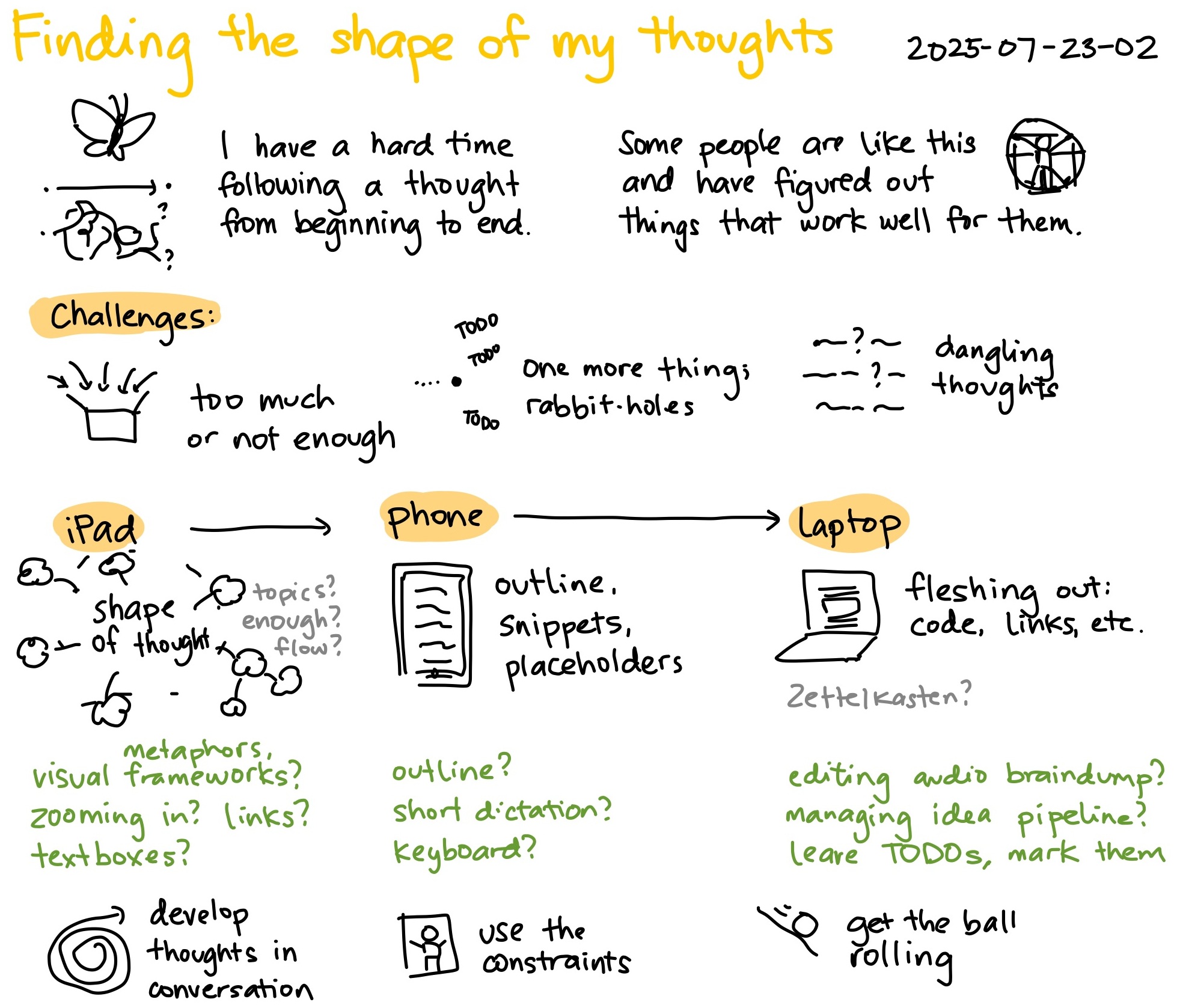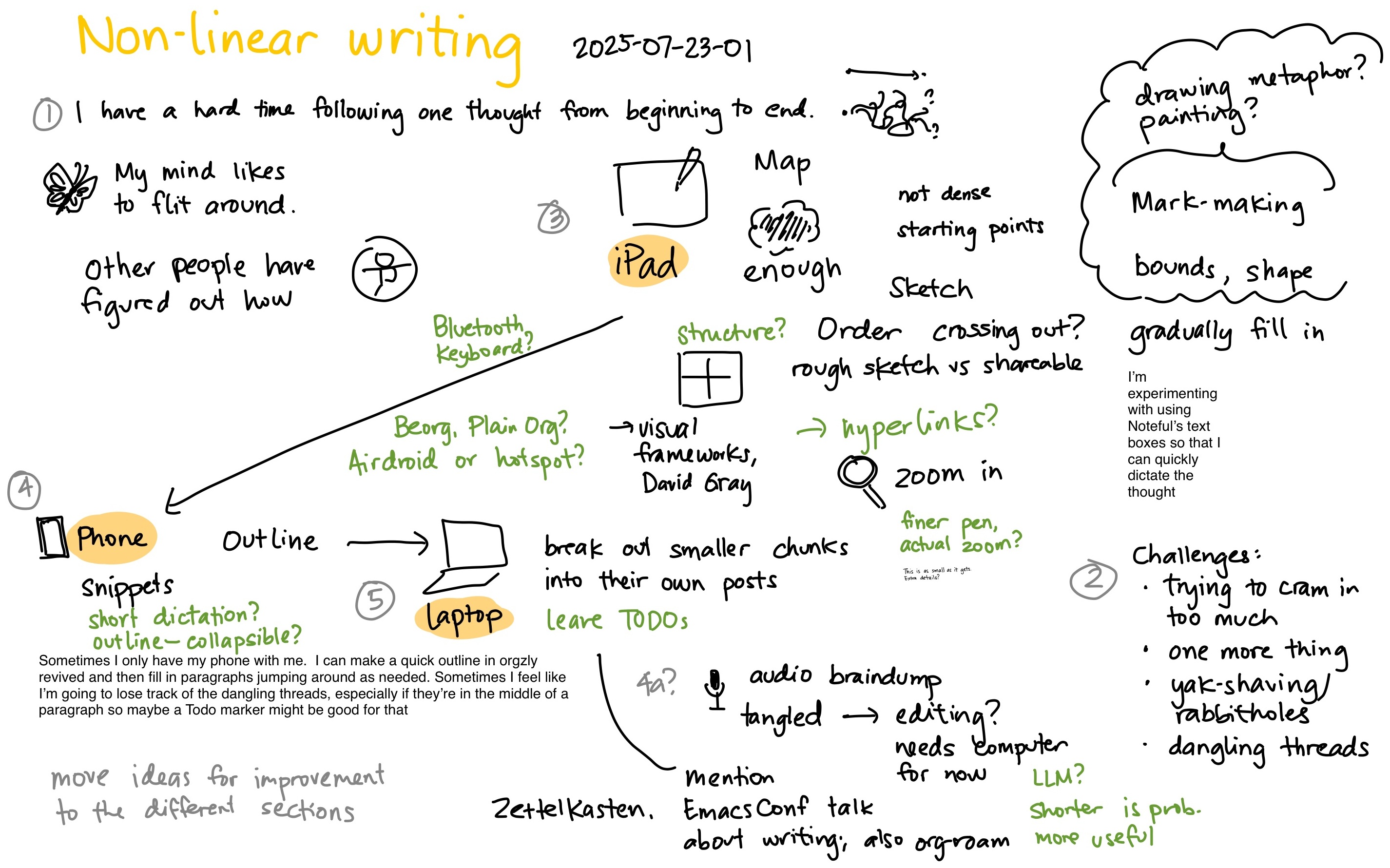Finding the shape of my thoughts
| emacs, org, writing
Text from sketch
Finding the shape of my thoughts 2025-07-23-02
I have a hard time following a thought from beginning to end.
Some people are like this and have figured out things that work well for them.
Challenges:
- too much or not enough
- one more thing; rabbit holes
- dangling thoughts
iPad
- shape of thought
- topics?
- enough?
- flow?
- metaphors, visual frameworks?
- zooming in? links?
- text boxes?
Phone
- outline, snippets, placeholders
- outline?
- short dictation?
- Keyboard?
Laptop
- fleshing out: code, links, etc.
- Zettelkasten?
- editing audio braindump?
- managing idea pipeline?
- leave TODOS, mark them
Overall:
- Develop thoughts in conversation
- Use the constraints
- Get the ball rolling
I want to write more. Writing better can follow, with practice and reflection. But writing is challenging. Coming up with ideas is not the hard part. It's finishing them without getting distracted by the hundred other ideas I come up with along the way. I have a hard time following one thought from beginning to end. My mind likes to flit around, jumping from one idea to another. Even when I make an outline, I tend to add to one section, wander over to another, come back to the first, get very deep into one section and decide it's probably its own blog post, and so on. Sometimes I want to say too much to fit into a blog post. Sometimes I start writing and find that I don't have enough to say yet. Sometimes I keep getting distracted by one more thing I want to do before I feel like I can finish the post. Sometimes an idea turns out to be a deep rabbit hole. Sometimes I can rein in those thoughts by using TODOs and next steps and somedays, but then I have all these threads left dangling and it doesn't quite feel right.
Fortunately, other people have figured out how to work with things like this. Roland Allen shares an example in The Notebook: A History of Thinking on Paper (2023):
P117. More commonly, [Leonardo da Vinci] expresses annoyance at his own distractability or perceived lack of progress. "Alas, this will never get anything done" is a theme that recurs in several notebooks.
Asked about the experience of looking at the "spine-tingling" notebooks, [Martin] Kemp employs strikingly kinetic language. "As material objects, they have an extraordinary intensity, little notebooks with this pretty tiny writing, done at great speed, great urgency, a kind of desperate intensity, when something else crowds in he has to jot it down, he goes back to the original thought, he gets diverted, he comes back to that page and will write some more… it's a very manic business."
My life is much smaller scale, but it's nice to know that other people have figured out or are figuring out how to work with how they are. For example, I've been drafting a post for July's Emacs Carnival theme of writing experience. Along the way, I found myself adding my blog posts as a consult-omni source, using that to add URLs to link placeholders, and writing this post about non-linearity. I'm very slowly learning to break those up into their own posts, or maybe even just save the idea as a TODO so that I can finish the thing that I'm writing before I get distracted by figuring out something else. It's easier to work with the grain than against it, so I follow wherever my curiosity leads, and then figure out what chunks I can break into posts.
I'm also coming to terms with the fact that I don't know what I'm writing until I write it and tweak it. No Athena springing forth fully-formed. The ideas develop in conversation: me with my sketches and text, and if I'm lucky, other people too. Sometimes there isn't enough there yet, so I need to put the idea aside for now. Sometimes there's too much I want to say, so I need to select things to focus on.
When I have an idea I want to write about, I like to start with drawing in Noteful on my iPad: sometimes a mind map, sometimes just words and phrases scattered on a page until I figure out which things are close to each other. I can select things with a lasso and move them closer together, and I can use a highlighter to choose things to focus on. This helps me get a sense of what I want to write about and what examples I want to use. Then I can take a step back and figure out the order that makes sense for the post.
My starting sketch for this post:
Text from sketch
Non-linear writing 2025-07-23-01
- 1. I have a hard time following one thought from beginning to end.
- My mind likes to flit around.
- Other people have figured out how
- 2. Challenges:
- trying to cram in too much
- one more thing
- yak-shaving / rabbitholes
- dangling threads
- 3. iPad
- Map
- enough
- not dense
- starting points
- Sketch
- Order
- crossing out?
- Structure?
- rough sketch vs shareable
- hyperlinks?
- Zoom in
- finer pen, actual zoom?
- This is as small as it gets. Extra details?
- Zoom in
- Bluetooth keyboard?
- Beorg, Plain Org?
- Airdroid or hotspot?
- visual frameworks, David Gray
- I'm experimenting with using Noteful's text boxes so that I can quickly dictate the thought
- 4. Phone
- Snippets
- short dictation?
- outline - collapsible?
- Sometimes I only have my phone with me. I can make a quick outline in orgzly revived and then fill in paragraphs jumping around as needed. Sometimes I feel like I'm going to lose track of the dangling threads, especially if they're in the middle of a paragraph so maybe a Todo marker might be good for that.
- Outline
- 5. Laptop
- break out smaller chunks into their own posts.
- leave TODOS
- Zettelkasten
- mention Emacs Conf talk about writing; also org-roam
- audio braindump
- tangled
- editing?
- needs computer for now
- LLM?
- Shorter is prob. more useful
- drawing metaphor?
- painting?
- mark-making
- bounds, shape
- gradually fill in
- move ideas for improvement to the different sections
Sometimes ideas peter out at this stage, when I find that I don't have much to say yet about it. I organize my Noteful notes by month, so I just leave the unfinished sketch there. I could probably tag it to make it findable again, but I usually end up moving on to other thoughts instead. If I want to revisit an idea later on, it's often easier to just make a new map. There are so many ideas I can explore, so it's good to quickly find out when I don't have enough to say about something. It might make more sense to me later on.
If I can figure out the rough shape of an idea and I feel like I have enough thoughts to fill it with, then it's time to figure out words. Swiping on an onscreen keyboard is more comfortable on my phone than on the iPad, although maybe that's just a matter of getting used to it. If I've developed the idea enough to have a clear flow, I can write the outline without referring to my sketch. If I happen to have a flat surface like a table, I can write while looking at my drawing. Once I have an outline on my phone, I can fill it in with paragraphs.
Sometimes it's easier for me to dictate than to type, like when I'm watering the plants. I use OpenAI Whisper to transcribe the recordings. The speech recognition is pretty accurate, but I have a lot of false starts, tangents, and rephrasing. My thoughts are rough and tangled, tripping over each other on their way out, but saying them out loud gets them down into a form I can look at. I still need to do a fair bit of work to clean up the text and organize it into my outline. Some people use large-language models to organize raw transcripts, but I haven't quite figured out a good prompt that turns a wall of raw text into something that's easy to include in my draft while retaining my voice. At the moment, I'd rather just manually go over my transcript for ideas I want to include and phrasings I might want to keep. As I massage the braindump into a post, I notice other things I want to add or rephrase. Maybe I'll get the hang of using voice input mode to dictate shorter snippets so that I can do it on my phone or iPad instead of needing computer time.
When I'm ready to expand these fragments into full posts, it's easiest to write on the computer, especially if I want to look up documentation or write code. My Orgzly Revived notes generally synchronize seamlessly with Org Mode in Emacs via Syncthing, aside from the occasional sync conflict that I need to resolve. Then I can build on whatever I started jotting down on my phone. Since I type quickly, thinking is the real bottleneck. If I've thought about things enough through my sketches or phone drafts, writing on my computer goes faster.
I find it easier to assemble a thought out of smaller snippets than to write from scratch, which is why Zettelkasten appeals to me. I still want to figure out some kind of approximate search, or even an exact search that can check Org entry text in a reasonable way. (Maybe org-ql…) My notes are not nearly as organized as people's org-roam constellations, but I'm starting to be able to pull together snippets of drafts, quotes from books, links to previous blog posts, and things I've come across in my reading.
Some ideas stall at this stage, too. M-x occur for "^\* " shows 65 top-level headings in my posts.org drafts. Sometimes it's because I've run into something I haven't figured out yet. Sometimes it's because the thoughts are still tangled. Sometimes it's because I've gotten distracted by other things, or a different approach to the same topic. I generally work on the more recent ones that are still in my mind. I also have a tree-map visualization that gives me a sense of the heft of each draft, in case the accumulation of words helps nudge me to finish it. It's okay for thoughts to take a while.

So my iPad is for sketching out the thought, my phone is for writing on the go, and my computer is for fleshing it all out. How could I make this better?
- iPad:
- What if I use more structure, visual frameworks, or metaphors, instead of starting from a totally blank page? That can help suggest things to think about, like the way a 2x2 matrix can help organize contrasts.
- I can zoom in and write with a thin stroke to add more detail. If I need even more space, I can link to a separate page.
- I can add textboxes and use voice input to quickly capture fragments of ideas as I draw.
- Phone:
- I can explore the outline tools of Beorg, Plain Org, or Orgzly Revived to see if I can get the hang of using them when I'm away from my computer.
- I can try the voice input on my phone. To keep the flow going, I need to resist the urge to correct misrecognized words as long as things are somewhat understandable.
- Maybe I can try bringing a Bluetooth keyboard to playdates where I'm likely to be near a table.
- Writing:
- I can run more ideas through my audio braindumping process so that I can improve my workflow.
- I can use Org Mode TODO states or tags to manage my idea pipeline so that I can keep track of posts that are almost there.
- I can be more ruthless about parking an idea as a TODO or a next step instead of feeling like I need to go write that post before I can finish this one. This might also help me write in smaller chunks.
Even if I have to rewrite chunks as I figure things out, that's not a waste. That's just part of how thoughts develop. I'm constrained by the tools that I use and the fragments of time that I have, but I can use those constraints to help me break things down into manageable pieces. If I take advantage of those little bits of time to get the ball rolling, writing at the computer becomes much easier and more fun. This is the kind of brain I've got, and I enjoy learning more about working with it.


